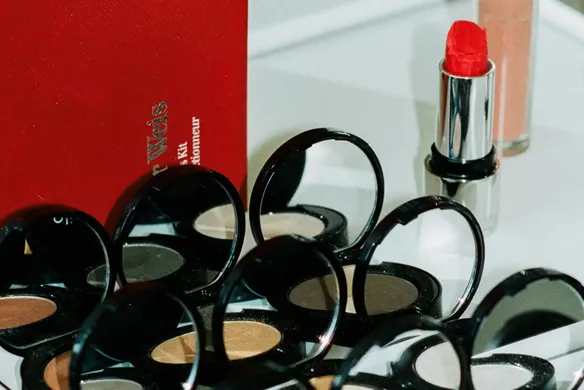Table of contents
This article is for educational purposes and does not constitute legal, financial, or tax advice. For specific advice applicable to your business, please contact a professional.
It goes without saying that consumers are looking for more than just a new pair of shoes online. Now more than ever, customers want to feel and look good, and the research supports this: The beauty market is projected to reach $580 billion by 2027, growing an estimated 6% per year, and the makeup industry specifically is poised to reap significant subsequent growth.
With imminent growth on the horizon, it’s important to set your online makeup business up for success and maximize your opportunity. Being strategic about your business plan, eCommerce site, marketing, and your products overall can help make your brand unique and competitive.
Here are a few things to consider when deciding to sell makeup online.
Step 1: Decide the kind of makeup you want to sell online.
The makeup industry is vast. From lip products to eye products, there are a number of entry points into the industry. More importantly, there are several gaps and niches waiting to be filled. When deciding the kind of makeup you want to sell, first understand what’s on the market and where the opportunities are. Outlining your target audience and performing market research can help you begin this process. With a better understanding of the landscape and the interests of your potential customers, you can make an informed decision of the type of product(s) that would best serve them. For instance, lips products for men with all natural ingredients fills a niche and uniquely serves a target audience. Think about what this would look like for your business.
Once you have an understanding of the type of products you’d like to sell and your target market, you can begin building out your full business plan. With two core aspects already in place, you can spend more time focusing on your competitive and financial analysis to help place your business on solid ground.
Step 2: Determine how you’ll make your products.
It should come as no surprise that producing makeup can almost be as challenging as putting it on. But the good news is that there are tons of options available to simplify this process. White labeling, partnering with a manufacturer, or purchasing items wholesale are just a few of the ways you can go about making your products.
White label: White-label products, also known as private-label products, are products manufactured with generic formulas and distributed to different retailers. This setup allows different brands to buy the same formula and add their own label, prices, or any other slight variations. White labeling is typically ideal for brands more concerned with their own branding or jumping on a trend than the product itself. To get started with this option, there are a number of platforms, like DHgate or Alibaba. You can also consider drop-shipping platforms that have cosmetic options.
Wholesale: Buying your items wholesale is another method that lets you skip the manufacturing process. Wholesale lets you resell products and curate an experience for customers based on any common themes, like organic products or products for specific skin types. Websites like Faire make it easy to find wholesale makeup products at fair prices. For businesses that use Square, Faire can easily be integrated into their online store, making managing inventory easier.
Custom manufacturing: Working with a manufacturer to create custom products is also a great option for makeup brands. This option is ideal for businesses that are looking to focus equally on their concept and their branding. Whether you desire to create a makeup brand that covers a range of underrepresented shades or a lip-care line made entirely of natural ingredients, working with a manufacturer can help bring your idea to life exactly as you intend. Sites like Maker’s Row can help you find factories, materials, or services that can manufacture your products and bring your business one step closer to launch.
Homemade: Last but not least, there’s the opportunity to make your makeup at home. Finding the right blend of powders, herbs, and other ingredients is crucial and can make or break how long your products will last and how they’ll look once applied. Do your research on any preferred ingredients and be thorough with any recipes you create on your own. Consulting scientists or another licensed party can help you ensure your products are safe and ready to distribute more broadly. Keep in mind that there are many regulations that may apply to how cosmetics are made and tested. Be sure to abide by any applicable laws or regulations in your region to protect your business.
Key Takeaway
There are four key ways to produce your own makeup line: white label, wholesale, custom manufacturing, and homemade.Step 3: Be thoughtful about packaging and labeling.
Once you make your products, it’s time to think about distribution. Before you choose how you’ll ship your products, decide on your packaging and labeling. Your packaging should be a direct extension of your business, with your logo and branding in prime position. For products that tend to double as an applicator, like lipstick, be intentional and creative with your design. Is your goal to prioritize ease of use? Or are you aiming to create a design that goes against expectations, like lipstick in a square-shaped tube that has a built-in mirror in its top? Be clear about your goal with manufacturers and be sure to stress-test the outcome before mass production.
When it comes to labeling, it’s imperative to include intended use case and instructions. Remember to follow the Cosmetics Labeling Guide created by the U.S. Food and Drug Administration and the Fair Packaging and Labeling Act, as well as any other applicable regulations. From placement of the label to the placement of the information section, the FDA has specific guidelines that must be followed to ensure your brand is compliant. If you plan to sell your products in more than one country, remember that each country has a different set of regulations.
Step 4: Build your online store.
With your products packed and ready to go, it’s time to sell. And selling online has major benefits: 37% of global consumers do their shopping online, according to Square Future of Commerce data. That number jumps to 42% for Gen Z consumers and 47% for millennial consumers specifically.
The ease of use of your online store has direct implications for your business. Ensuring that your site is easy to navigate, has an obvious search bar, and has items appropriately sectioned off makes it easy for customers to find everything they need to make a sale. Square makes it quick and efficient for businesses to build a professional website and accept a variety of payments. With mobile-friendly designs, your customers can seamlessly shop on the go wherever they are.
Square Photo Studio can help take your website to the next level by ensuring that you have high-quality images of your makeup items taken directly from your phone. With features that allow you to edit the lighting, remove the background, and more, you’re able to capture and share the very best of your products, helping customers make informed purchase decisions.
With a solid platform and product images in place, be sure your site is easily discoverable by search engines. Everything from how you name your products to how you categorize your items matters. Utilizing SEO best practices can help you maximize your reach and grow your business.
Step 5: Set up a marketing plan.
Once your online store is up and running, it’s time to market your business to the world. Putting together a marketing strategy can help you set clear tactics and goals, assess your strengths and weaknesses, and gain a better sense of who your target customers are. Expanding on the market research you performed in the first step, you can understand what influences purchase decisions and how your competitors are winning customers, both of which can help steer your overall marketing approach.
Because there are several different types of marketing, like email, SMS, and social media marketing, it’s important to be strategic about how you use each channel. SMS marketing, for instance, should be snappy and less than 300 characters. Email marketing, on the other hand, allows you to be a bit more creative and play with your overall layout. Square Marketing makes it easy for you to send both SMS and email messages to customers, and with built-in AI features like copy generators, you can manage campaigns quicker and get more time back in your day.
Paid ads are another must when it comes to your online business. Search engines and social media channels have paid ad options that can put your store directly in front of customers in places where they spend most of their time. Sites like TikTok have in-feed options that fit neatly within the scrolling experience, seamlessly reaching customers. For paid ads — and your marketing overall — be sure to budget for all of your marketing strategies appropriately so that you can maximize your efforts.
Frequently Asked Questions :
Do you need a license to sell cosmetics online?
Whether or not you’ll need a license to sell cosmetics online depends on the ingredients in your products and where your products will be shipped. To understand the rules and regulations as they relate to your business, review FDA and state guidelines and consider consulting a professional.
What are the most popular types of cosmetics?
According to Elle, some of the most popular makeup trends and products of 2023 include liquid blush, cream contour, and cat eyelashes. Because trends often change just as quickly as they come, consider leaning into staple makeup products that will always be relevant like foundation, mascara, and lip products.
What are the best online marketplaces to sell makeup?
Aside from your own unique online store built with a platform like Square, you can also sell your makeup on other online platforms to boost your reach. Sites like Poshmark, Glambot, Etsy, eBay, as well as Meta platforms like Instagram and Facebook Marketplace, are also great places to sell. Keep in mind that each platform will have its own payment methods, some of which may limit customers. Having your own online store with flexible payment options like Afterpay can make your store more desirable to customers who may be on a budget.
Can I start a makeup line with no money?
Starting any business requires some sort of investment. However, if you’re hoping to start a makeup line in an affordable way, drop shipping could be a viable option. Drop shipping is a fulfillment method that allows you to function as the middleman between the manufacturer and the consumer. The best part about drop shipping is that you don’t have to worry about keeping any inventory on hand — your brand essentially acts as a storefront, and once a customer places an order, it goes straight to the manufacturer for processing and shipping. While drop shipping makes the initial process easier, there can be some drawbacks, so be sure to do your research and decide what works best for your business goals.
![]()







